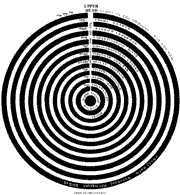




I. The Etz HaChayyim (Tree of Life) of Rabbi Yitza'aq
Luria
Rabbi Yitza'aq Luria (1534-1572 CE) is a highly esteemed Jewish Kabbalist
who lived in Safed in Israel. He is widely known as "HaAri"
(The Lion). The expulsion of the Jews from Spain in 1492 set into motion
a tide of momentum that led to Safed becoming a center for the revitalized
study of the Jewish Kabbalah, in which Luria was a central figure. Rabbi
Luria dictated the Etz HaChayyim (Tree of Life) to
his student Chayyim Vital. It is composed of ten "Branches" and
is deeply rooted in the Zohar (Book of Splendor). It
is clearly the most intellectually complex of the principal works of written
Qabalah, and attracts the lion's share of interest amongst present-day (non-occult)
Qabalists.
 The text of the Etz HaChayyimEtz HaChayyim Branch 1:
The text of the Etz HaChayyimEtz HaChayyim Branch 1:
"In His simple and smooth Will, the desire arose to (make a)
Creation. Behold, He then contracted (tzimtzum) Himself in
the middle point...He contracted the Light (of the Endless).
And the Light was withdrawn to the sides around the middle
point, and there remained an empty space, atmosphere (ryva,
Ether), and a vacuum surrounding the exact middle point.
And, behold, the contraction was evenly balanced around
that empty middle point in such a manner that the vacuum
was circular and in complete balance and sameness all
around..." describes the emanation of the "smooth and simple" Light of the Endless (Ayn Sof Or),
from Its unmanifest condition into the pattern of the Sefiroth of the Tree
of Life within the "Sphere of Contraction" (Tzimtzum).
In the Etz HaChayyim, the Central Column of the Tree is called
the Kav (Line of Light), and the names used for the Sefiroth are
exclusively Zoharic. The Lurianic cosmogony elucidates a system of partzufim,
or "veils," positioned on the Tree. The Etz HaChayyim
is a source for several unique forms of the Tree of Life. One form renders
the Sefiroth as a pattern of ten concentric circles , like "layers of an onion." Two other Trees are
set upon a version of the vertical arrangement of the letters of the Name
YHVH mentioned in the description of the Sh'ir Qoma (Measure
of the Divine Body).
Luria is particularly noted for his doctrine of the Shevirat HaKelim,
or the "Shattering of the Vessels." This doctrine widely influenced
many Qabalists who followed, including Sabbatai Zevi and the Baal Shem Tov
(the father of Chasidism). The core idea of the Shevirat HaKelim
is that the Totality was shattered at the moment of creation (mirroring
the Big Bang Theory). From this inflationary event, "holy sparks"
flew off in all directions. Some returned, and others became embodied in
all forms of matter. From this arose the idea of Tikkun Olam, or
the "Perfection of the World," in which all the holy sparks return
to the state of unity that preceded the creation of the universe. A parallel
in Chaos Theory is the concept of a "disturbed system" that strives
to revert to a former condition of quasi-stationary equilibrium. The Work
of the Chariot Trust published the first English translation of all ten
Branches of the Etz HaChayyim in 1973.
The next section of this site presents the complete teachings from the Work of the Chariot on the core ideas of the Mystical Qabalah .